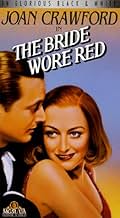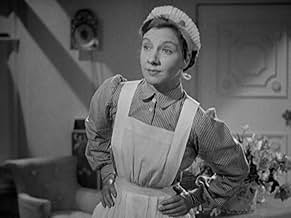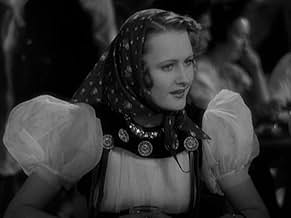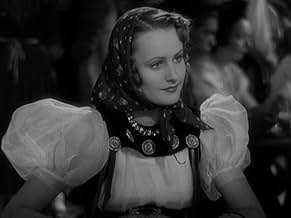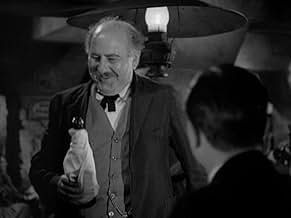IMDb-BEWERTUNG
6,3/10
1323
IHRE BEWERTUNG
Füge eine Handlung in deiner Sprache hinzuA lounge singer is sent by a count to pose as a wealthy socialite.A lounge singer is sent by a count to pose as a wealthy socialite.A lounge singer is sent by a count to pose as a wealthy socialite.
Mary Philips
- Maria
- (as Mary Phillips)
Rafael Alcayde
- Hotel Clerk
- (Nicht genannt)
Nino Bellini
- Cosmos Club Waiter
- (Nicht genannt)
Agostino Borgato
- Cordellera Bar Waiter
- (Nicht genannt)
Adriana Caselotti
- First Peasant Girl
- (Nicht genannt)
Robert Cauterio
- Hotel Clerk
- (Nicht genannt)
Irene Coleman
- Cosmos Club Hat Check Girl
- (Nicht genannt)
Gino Corrado
- Cosmos Club Croupier
- (Nicht genannt)
Empfohlene Bewertungen
I had high hopes for this one. The plot sounded good. Eccentric Count Armalia (George Zucco) believes that luck of birth is all that separates the rich from the poor. To prove his point, he sets up dive singer Anni (Joan Crawford) as a fake socialite to fool his rich friends. This works but snobbish Robert Young falls for her and wants to marry her. Anni sees the chance to get out of poverty by marrying a rich guy but, at the same time, she has started to fall for poor Franchot Tone. So it becomes a question of whether Anni will choose love or money. Glossy MGM soaper with a nice cast but somehow just misses the mark. It was nice seeing George Zucco in a different kind of role. Also Billie Burke is sort of evil, which is interesting. See it for the cast or out of curiosity. You might enjoy it more than me.
Well, you can't blame Joan for trying. Always wanting to go beyond that glamorous clothes-horse/shopgirl-makes-good mold in which MGM so successfully cast her throughout the 1930's, she was always attempting to outreach her grasp. When Metro's Austrian star Luise Rainer backed out of making a film of Molnar's THE GIRL FROM TRIESTE, a dark photoplay about a prostitute sent on a masquerade in the Tyrolean Alps, Crawford grabbed it, hoping to get her teeth into a meaty role. Imagine her chagrin when Metro executives "improved" the piece to be more suitable for Crawford's image, taking the meat and guts with it. What emerged was an uncomfortable picture built on compromises in an attempt to graft a typical Crawford/Cinderella plot onto what is basically a nasty, mean little story. Registering far below the Crawford usual at the paybox, THE BRIDE WORE RED started her career to skid.
A closer look, however, reveals that not all of the edge has been softened from the piece. I wholeheartedly agree with the reviewer who calls this Joan's most underrated performance, and there is a reason we do not sympathize with this Cinderella. Crawford's Anni is cold and snappish, and has the potential to do real harm to some nice, decent folk. The film plays like the dark side of all of those rags-to-Adrian gown stories Crawford played in the Metro phase of her career, and CRAWFORD IS FULLY AWARE OF THIS. Although seemingly played straight, there is an irony underneath that tells us Crawford herself isn't crazy about Anni either. It's understandable that 1937 audiences did not warm to a Joan they couldn't root for (even her hair is cut into a severe, but stunning, pageboy), but it deserves real recognition now that we are removed from the era and have seen ALL the phases of Crawford's career. In many ways, it's a harbinger of the darker, icier roles she was to play at Warner Bros. and throughout the 1950's.
The performances are uniformly good, with George Zucco strong as the decadent, evil Machiavelli who sends Anni on her masquerade, but Crawford, for the most part, is the standout. Only in the early scenes of the film, when she attempts to portray Anni as a world-weary honky tonk singer (in what must have been the cleanest, most glamorous "dive" in all of Trieste!!) does she fail to convince.
(Ironically, Crawford's next film, MANNEQUIN, released early in 1938 and co-starring Spencer Tracy, was a strictly paint by the numbers Rags-to-Adrian tale, inferior to this, that found great favor with the movie-going public.)
A closer look, however, reveals that not all of the edge has been softened from the piece. I wholeheartedly agree with the reviewer who calls this Joan's most underrated performance, and there is a reason we do not sympathize with this Cinderella. Crawford's Anni is cold and snappish, and has the potential to do real harm to some nice, decent folk. The film plays like the dark side of all of those rags-to-Adrian gown stories Crawford played in the Metro phase of her career, and CRAWFORD IS FULLY AWARE OF THIS. Although seemingly played straight, there is an irony underneath that tells us Crawford herself isn't crazy about Anni either. It's understandable that 1937 audiences did not warm to a Joan they couldn't root for (even her hair is cut into a severe, but stunning, pageboy), but it deserves real recognition now that we are removed from the era and have seen ALL the phases of Crawford's career. In many ways, it's a harbinger of the darker, icier roles she was to play at Warner Bros. and throughout the 1950's.
The performances are uniformly good, with George Zucco strong as the decadent, evil Machiavelli who sends Anni on her masquerade, but Crawford, for the most part, is the standout. Only in the early scenes of the film, when she attempts to portray Anni as a world-weary honky tonk singer (in what must have been the cleanest, most glamorous "dive" in all of Trieste!!) does she fail to convince.
(Ironically, Crawford's next film, MANNEQUIN, released early in 1938 and co-starring Spencer Tracy, was a strictly paint by the numbers Rags-to-Adrian tale, inferior to this, that found great favor with the movie-going public.)
In about 1980 I saw this film at the UCLA Film Archives in a series presenting Dorothy Arzner directed films. There was a guest speaker at the event who was a personal friend of Arzner's. I don't remember her name, but she was introduced as, among other things, the writer for the script of "Craig's Wife" (1936; starring Rosalind Russell).
She said she was on the set for some of the shooting of "Bride Wore Red," and described how Joan Crawford was completely uncooperative with the director. Originally it was written for Luise Rainer but for some reason she was unavailable. "So they got Joan Crawford who wasn't anything like her," and was not suited for the film in this woman's opinion. While she was on the set she witnessed how Dorothy Arzner would gently make suggestions as to how to play a scene, "...and Joan would scream, 'You'll destroy me! You'll destroy me!' and she would run up to L.B. Mayer and he would say, 'There, there Joan, play it your way." So she did, "...and frankly, the film bombed. But when you have a star that is entirely uncooperative, you can't blame the director." I hope I have quoted this woman accurately. That is what has stuck in my memory. I am a big Crawford fan, but her flaws were apparently spectacular. I just thought it would be interesting to record this bit of info.
She said she was on the set for some of the shooting of "Bride Wore Red," and described how Joan Crawford was completely uncooperative with the director. Originally it was written for Luise Rainer but for some reason she was unavailable. "So they got Joan Crawford who wasn't anything like her," and was not suited for the film in this woman's opinion. While she was on the set she witnessed how Dorothy Arzner would gently make suggestions as to how to play a scene, "...and Joan would scream, 'You'll destroy me! You'll destroy me!' and she would run up to L.B. Mayer and he would say, 'There, there Joan, play it your way." So she did, "...and frankly, the film bombed. But when you have a star that is entirely uncooperative, you can't blame the director." I hope I have quoted this woman accurately. That is what has stuck in my memory. I am a big Crawford fan, but her flaws were apparently spectacular. I just thought it would be interesting to record this bit of info.
The Bride Wore Red is based on an unpublished Ferenc Molnar play which he probably couldn't get anyone on Broadway interested in. So for a reduced rate he sold the property to MGM which gave it the usual lavish MGM treatment.
American accents which bothered some other reviewers didn't bother me. Sometimes they stand out, sometimes they don't. In this case Joan Crawford was cast in a role she played dozens of times before as the poor girl given a chance at riches and does she grab.
This variation on the Pygmalion theme starts in a café in Trieste where Crawford sings and presumably will do other things for her supper. It's in the red light district of Trieste. Count George Zucco hires her on a whim to prove that clothes and manner do make the individual. Zucco showers Crawford with a new wardrobe giving her the chance to show off those Adrian gowns and gives her two weeks at a resort in the Tyrol where the high society pleasures itself.
To make this last though Crawford has to land a husband and she lands on Robert Young. But he's slightly engaged to Lynne Carver, a sweet young thing. They're traveling with friends Reginald Owen who is a foxy old rogue and married to Billie Burke who has to watch the fox like a hawk.
The local postman Franchot Tone is interested in her, but Crawford figures to do better than him. Her only friend is a former café colleague in Mary Phillips who is working as a maid in that hotel. Though the experiment is Pygmalion like, Crawford feels more like Cinderella with the clock inevitably ticking towards midnight.
I think you can probably figure out where this all ends if you're any kind of film fan and Crawford fan. Dorothy Arzner's direction sharpens the character that Crawford created in Grand Hotel as an anxious to rise stenographer taking her couple of steps lower in society and seeing if she can make the climb.
Franchot Tone who was married to Joan Crawford at the time got a break of sorts in this film. Normally he'd be the society guy who Crawford is trying for. As the common, but somewhat erudite postman for once he's not in formal wear in a film.
Another surprise is Billie Burke who together with Mary Boland and Spring Byington was busy playing delightful airheads in her film. She's quite serious and quite good, but inevitably went back to being typecast after this film was completed.
The Bride Wore Red will please Joan Crawford fans immensely and this is a most typical example of the kind of character she played in her years at MGM.
American accents which bothered some other reviewers didn't bother me. Sometimes they stand out, sometimes they don't. In this case Joan Crawford was cast in a role she played dozens of times before as the poor girl given a chance at riches and does she grab.
This variation on the Pygmalion theme starts in a café in Trieste where Crawford sings and presumably will do other things for her supper. It's in the red light district of Trieste. Count George Zucco hires her on a whim to prove that clothes and manner do make the individual. Zucco showers Crawford with a new wardrobe giving her the chance to show off those Adrian gowns and gives her two weeks at a resort in the Tyrol where the high society pleasures itself.
To make this last though Crawford has to land a husband and she lands on Robert Young. But he's slightly engaged to Lynne Carver, a sweet young thing. They're traveling with friends Reginald Owen who is a foxy old rogue and married to Billie Burke who has to watch the fox like a hawk.
The local postman Franchot Tone is interested in her, but Crawford figures to do better than him. Her only friend is a former café colleague in Mary Phillips who is working as a maid in that hotel. Though the experiment is Pygmalion like, Crawford feels more like Cinderella with the clock inevitably ticking towards midnight.
I think you can probably figure out where this all ends if you're any kind of film fan and Crawford fan. Dorothy Arzner's direction sharpens the character that Crawford created in Grand Hotel as an anxious to rise stenographer taking her couple of steps lower in society and seeing if she can make the climb.
Franchot Tone who was married to Joan Crawford at the time got a break of sorts in this film. Normally he'd be the society guy who Crawford is trying for. As the common, but somewhat erudite postman for once he's not in formal wear in a film.
Another surprise is Billie Burke who together with Mary Boland and Spring Byington was busy playing delightful airheads in her film. She's quite serious and quite good, but inevitably went back to being typecast after this film was completed.
The Bride Wore Red will please Joan Crawford fans immensely and this is a most typical example of the kind of character she played in her years at MGM.
The Bride Wore Red is a ridiculous but fun film. A drunken count, slumming it for the night, runs into a cynical and hungry young woman, Anni Pavlovitch (Joan Crawford). He decides to send her on a luxury vacation to prove his drunken point that the poor and the rich aren't so different after all and buys her new clothes and arranges for her to stay in a luxury resort. Anni, who obviously thinks the whole thing is crazy, decides to go threw with it anyway. Arriving in the alps she meets Giulio (Crawford's real life husband, Franchot Tone) a very pert mail employee who immediately takes a shine to her. The two have sparks aplenty, but when she arrives at the hotel Anni quickly realizes that she would rather always have food on her table than the love of a good man, and quickly sets about seducing Rudi, a flighty engaged man who is very taken with her.
As with most romcoms the real test is if the chemistry works and here it does perfectly. Crawford and Tone have excellent chemistry here and he is very sweet and naive, persistently wearing down the jaded and bitter singer.
It's a lovely sweet film.
As with most romcoms the real test is if the chemistry works and here it does perfectly. Crawford and Tone have excellent chemistry here and he is very sweet and naive, persistently wearing down the jaded and bitter singer.
It's a lovely sweet film.
Wusstest du schon
- WissenswertesDuring filming, an electrician fell from the catwalk high above the set, narrowly missing the film's star, Joan Crawford. Shooting was temporarily halted while the man was rushed to hospital. Crawford refused to resume production until she was assured that the man would be fully cared for, that he would remain on salary, and that his family would be provided for. Crawford also called the hospital each day afterwards for reports on his condition.
- Zitate
Rudolph 'Rudi' Pal: In my opinion, most people prefer sardines to caviar because most people haven't tried caviar.
- Crazy CreditsDuring the opening credits, a music box is shown playing a tune in the background.
- VerbindungenFeatured in The Romance of Celluloid (1937)
- SoundtracksWho Wants Love?
(1937)
Music by Franz Waxman
Lyrics by Gus Kahn
Sung by Joan Crawford (uncredited) at the Cordellera Bar
Played throughout as part of the score
Top-Auswahl
Melde dich zum Bewerten an und greife auf die Watchlist für personalisierte Empfehlungen zu.
- How long is The Bride Wore Red?Powered by Alexa
Details
- Erscheinungsdatum
- Herkunftsland
- Sprache
- Auch bekannt als
- The Bride Wore Red
- Drehorte
- Österreich(Alpine exteriors)
- Produktionsfirma
- Weitere beteiligte Unternehmen bei IMDbPro anzeigen
Box Office
- Budget
- 960.000 $ (geschätzt)
- Laufzeit1 Stunde 43 Minuten
- Farbe
- Seitenverhältnis
- 1.37 : 1
Zu dieser Seite beitragen
Bearbeitung vorschlagen oder fehlenden Inhalt hinzufügen

Oberste Lücke
By what name was Die Braut trug rot (1937) officially released in Canada in English?
Antwort

